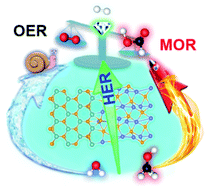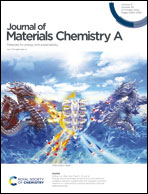Energy-saving hydrogen production by the methanol oxidation reaction coupled with the hydrogen evolution reaction co-catalyzed by a phase separation induced heterostructure †
Abstract
Electrochemical water splitting is a desirable technique to produce hydrogen to replace fossil fuels for sustainable energy generation. However, efficient hydrogen production suffers from a sluggish oxygen evolution reaction (OER) and expensive electrocatalysts. Herein, the methanol oxidation reaction (MOR) is combined with the hydrogen evolution reaction (HER) to achieve energy-saving hydrogen production. The HER and MOR are co-catalyzed by a bifunctional electrocatalyst containing a NiSe/MoSe2 heterointerface on carbon cloth (NMS/CC). The electronic structure rearrangement and charge transfer at the heterointerface are investigated experimentally and theoretically. The NMS/CC electrocatalyst has outstanding MOR properties requiring a smaller potential and Tafel slope than those of the OER as well as high efficiency and stability. Energy-saving hydrogen production by the combined MOR/HER configuration can be powered by a solar cell with an output voltage of 1.5 V. The results reveal the excellent prospect of this novel strategy for zero-carbon-emission energy generation and provide insights into the coordination of electrosynthesis and electrocatalysis.

- This article is part of the themed collection: Editor’s Choice 2023: Advancing electrocatalysts for a sustainable future.


 Please wait while we load your content...
Please wait while we load your content...